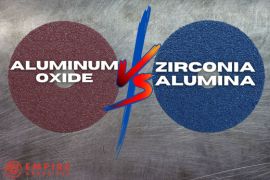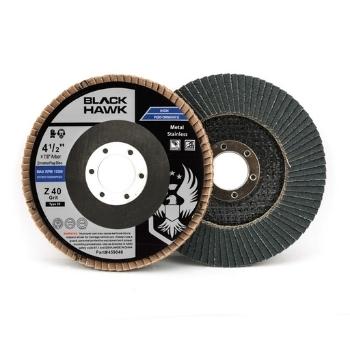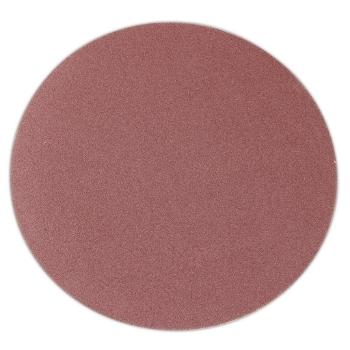
Aluminum oxide and zirconia alumina (zirc) are two of the most popular sanding materials for durability, versatility, and overall result. However, deciding which abrasive works best for your project can be confusing at times, and choosing the wrong material may end in ruining the project you’re working on.
Read on for more information comparing aluminum oxide vs zirconia abrasives, when to use each material, and abrasive grains in general.
What is an Abrasive Grain?
Abrasive grains are solid, hard materials that rub away surface material using pressurized contact.
Abrasive grains diminish unwanted material like an exfoliant getting rid of dead skin.
Some abrasive grain products are sanding belts, grinding wheels, and flap wheels. Abrasive grains help shape rugged materials like concrete, rock, gems, and metal.
Abrasive grains may be all-natural, synthetic, or a combination of artificial and raw materials.
Everyday products like household cleaners, jewelry cleaners, and sanding belts are customary abrasive grain-derived derivatives.
Other commonly used abrasive grain types are silicon carbide, ceramic alumina, and synthetic diamond. Precious gems like garnet, emery, and quartz are also considered abrasive grains. Synthetic diamond makes an excellent abrasive grain for grinding the most arduous materials.
Choosing the right abrasive grain depends on your desired finish and the robustness of the material you use. Critical aspects of narrowing down your decision include:
- Grit level
- Rigidity
- Character of fracture
- Uniformity
Grit level is the most vital when choosing your abrasive grain, as it describes the density of the abrasive and its strength against other materials.
If you have a material like metal, you will need an abrasive with plenty of rigidity and grit. Softer materials like wood do not require as vigorous of abrasive grain. Ensuring you use the correct form of abrasive grain will save you time, money, and effort.
What is Aluminum Oxide?
Aluminum oxide is one of the most popular abrasive grains for durability and ease of use. Around 90% of all manufactured abrasive grains have some degree of aluminum oxide.
Aluminum oxide naturally comes from bauxite. Bauxite is the primary natural source of aluminum. To turn it into an abrasive grain, manufacturers boil it down at almost 1000 degrees Celsius to remove any remaining water. If there is too much water in the bauxite, the aluminum oxide will be of poor quality and will likely not end up in the final product.
Once the bauxite has suitably melted down, ground coke and iron borings enter the mixture. An electric current that tops off at about 2000 degrees melts the bauxite further, and the cycle continues until the pot becomes full. Then, the aluminum oxide comes out of the furnace and cools before manufacturing.
Workers love aluminum oxide as an abrasive grain because of its low-iron content. The lack of iron results in an anti-rust material, making it ideal to use on many metal grinding tools.
However, sandpaper is the most widely used material made from aluminum oxide.
Whether formed in a block structure, classic sheet formation, or a grinding wheel, aluminum oxide is a tried-and-true abrasive grain.
What is Zirconia Alumina?
 Often employed for sandblasting and sanding discs, zirconia alumina, is the crystallized result of aluminum oxide and zirconium dioxide. The result is a coarse abrasive grain that works well for grinding down medium-to-coarse materials.
Often employed for sandblasting and sanding discs, zirconia alumina, is the crystallized result of aluminum oxide and zirconium dioxide. The result is a coarse abrasive grain that works well for grinding down medium-to-coarse materials.
Another use of zirconia alumina is foundry or casting due to its heat-resistant properties. Zirconium is firmer than aluminum oxide, can endure astonishingly heavy loads, and usually lasts longer than aluminum oxide products as well.
Other appealing details are:
- Zirconia alumina self-sharpens with every use (friability)
- Performs best in high-pressure environments
- Suited for hard materials, such as stainless steel
You will find zirconia alumina in sanding belts and discs, and experienced or novice workers find it easy to use and durable for challenging or time-consuming projects.
What are Aluminum Oxide Abrasives Used For?
There are three colors of aluminum oxide sandpaper: brown, white, and pink. Each tint works well as an abrasive grain, but they also serve specific purposes. White and pink wear out faster than brown sandpaper but are less aggressive and do not produce as much heat, making them best suited for painted surfaces or delicate wood.
Brown aluminum oxide sandpaper is durable and rugged, and most likely what you imagine when you hear the word sandpaper. This form of aluminum oxide works well on difficult-to-work-with substances like fiberglass and drywall. The finish may not be as smooth, but brown sandpaper is comprehensively easier to find and lasts longer than its colorful counterparts.
A few common uses for aluminum oxide abrasives are:
- Etching
- Paint stripping
- Lapping
- Rust removal
Depending on the type of product and the backing material, it is possible to use aluminum oxide abrasives on wet or dry materials and through relatively high pressure. They work well for paint adhesion and create a smooth finish on walls.
Types of Aluminum Oxide
Not all aluminum oxide sandpapers are created equal. You should choose the proper type of aluminum oxide for your desired end product.
The four subtypes of aluminum oxide are friable, semi-friable, regular, and heavy-duty.
Friable aluminum oxide is the softest grain, while heavy-duty has more density.
A friable aluminum oxide continuously forms sharp edges during use, so you never have a dull grit. White aluminum oxide is the most friable of the colors.
Brown aluminum oxide is semi-friable. This type of aluminum oxide suits projects that require quick cutting and relatively cool temperatures. Regular and heavy-duty aluminum oxides perform best in large projects, like sanding a non-skid floor or powder coating.
Belts
Aluminum oxide sanding belts are a very popular type of abrasive product using aluminum oxide for individuals looking to grind down more material much faster than by using sandpaper by hand. The sanding belts come in a variety of sizes for different belt sander tools from handheld to stationary.
Note that you should never use an aluminum oxide belt for wet operations. For specific products, aluminum oxide alone works wet and dry (as mentioned earlier), but it is recommended to use zirconia or ceramic belts for wet sanding.
What are Zirconia Abrasives Used For?
In simple terms, zirconia abrasives work their magic for extremely tough metal, high-heat, and high-pressure materials.
The natural durability of zirconia (also called zirc) makes it ideal for manufacturing operations and grinding down rough exteriors. Zirconia alumina requires a decent amount of pressure to perform well.
One of the primary uses of zirconia alumina is getting rid of bumpy spots in materials like tungsten, carbon steel, stainless steel, and titanium.
Other materials that mesh well with zirconia alumina are:
- Tool steel
- Cast iron
- Blades
- Rotors
Steel fabrication shops use zirconia alumina for high-intensity construction and grinding. However, they are not ideal for polishing. They are much too dense and robust and will destroy a soft metal or wood.
Zirconia alumina is a premier choice for sanding belts and discs, as their grains sharpen over prolonged use and do not require replacement until the grit fades.
Sandpaper is less commonly used for regular sandpaper. Since it is so effective at aggressive grinding on harder metals, you’ll often find them on products like flap discs, spiral bands, grinding belts, and zirconia resin fiber sanding discs. You’ll find them in various shades of green and blue.
Zirconia alumina is highly friable and allows for lower-temperature grinding than aluminum oxide. Despite the high price tag, many people find it worth the investment because of its longevity and time-saving ability.
Aluminum Oxide or Zirconia Abrasives - When to Choose Each
Before deciding on aluminum oxide or zirconia, consider the project you wish to complete. Is it something substantial, like sanding drywall or shaping stainless steel? Or, is it a smaller chunk of wood or metal that you plan to use for decor? Significant projects with heavy-duty materials call for zirconia, but smaller-scale operations work fine with aluminum oxide.
Next, look at your materials. Soft, spongy wood, painted wood, and other delicate materials call for a smoothly-textured aluminum oxide sandpaper, such as the pink or white color. Less delicate projects like stainless steel or ragged wood are a breeze with zirconia alumina.
Materials that require high temperatures for malleability fall under the aluminum oxide category, as the friction between the sandpaper and the material generates plenty of heat.
Finally, consider your budget. While it is long-lasting, durable, and a time-saver, you will have to shell out more money for zirconia alumina. Aluminum oxide is also much more readily available in different types of abrasive products and is a much more affordable abrasive grain, making it the go-to choice for most consumers.
Still Have Questions
We know how important it is to choose the right abrasives for your projects. If you still have questions about whether to choose aluminum oxide or zirc, we have abrasive specialists here to help by email, chat on the website, or by phone during regular business hours.

